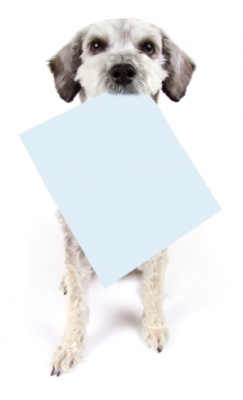Open Paw's No-Frills Explanation of How Dogs Learn

Dogs are very efficient in their behavior. If a behavior is inherently pleasurable (eating, playing, chasing, etc), or if doing a particular behavior gets something pleasurable for the dog (like food, attention, or social interaction), the dog will display that behavior more and more often. If a behavior is not pleasurable, if it does not work to obtain something pleasurable, or results in something unpleasant, the dog will use that behavior less and less. Whenever you interact with a dog, you’re constantly giving her feedback about what works to get the good stuff and what doesn’t work. If a dog jumps up and gets attention, even if the attention is that you push him, then he knows that jumping “works” -– that is, it gets him attention and social interaction. If a he accidentally bites you in play and you don’t end the game, then he learns that play biting “works” or at least is not a serious impropriety -– the fun continues. So you can see why it is very important to manipulate the consequences of your dog’s behavior to be sure he is getting the right messages from you. This is a big responsibility.
The good news is that we can easily use the way dogs learn to “sculpt” their behavior, by consistently rewarding the desirable behaviors we see and ignoring or interrupting the undesirable behaviors. Gradually, you will see your dog behaving more and more in desirable ways, and less and less in undesirable ways.
But what about, for example, dogs who jump all the time? Well, that’s just it: no dog ever jumps literally all the time. Even with a dog that jumps a lot, there’s a moment when she isn’t jumping, so reinforce that moment with attention and some food! If you don’t like what she’s doing, show her what you would like her to do and then reinforce the new behavior.
Repetition and patience are key elements in dog training. There’s never a magic moment when the dog understands the meaning of our requests. Animals gradually become conditioned through lots of repetition that certain behaviors in certain situations will or will not “pay off.”
We use these principles -– rewarding desirable behaviors and ignoring undesirable behavior or removing rewards when the animal behaves in an undesirable way -– in Open Paw training, and do not use physical punishment. Dogs make associations with you and with the situation every time you interact with them. Thus, an unfortunate side effect of using punishment to try to train animals is that, while they may learn to respond to cues, or to stop doing something you don’t like, they may also form negative associations to you, to the situation, the environment, to people in general, or to training.
Furthermore, often you don’t get the result you wanted from trying to use punishment to train. Take for example a dog jumping on people. It’s not a desirable behavior to people, but in the dog-dog world this is usually an appeasing, friendly greeting gesture. If you use punishment to try to get the dog to stop jumping, you have to use a severe enough punishment the first time that it effectively outweighs the positive associations of the friendly greeting gesture. If the punishment is not severe enough, then, you are not effectively damping that behavior. You may even unintentionally be rewarding it. Furthermore, even if you succeed in punishing severely enough, some dogs may try to stop the punishment by offering an appeasement gesture rather than by stopping the undesirable behavior– so the result might be more rather than less jumping.
So, using punishment to train is pretty inefficient, difficult to do correctly, and, in order to be effective, must be severe. A much more efficient, friendlier way to train is to teach the dog a desirable, incompatible behavior: ask yourself, “If this is ‘wrong,’ what is ‘right’? In the case above, you could train the dog to sit to greet people instead of jumping.
Please keep in mind, physical punishment can jeopardize your relationship with your dog or cause her to become defensive or fearful. Surely that is not your goal. Besides, dogs aren’t trying to be “bad” when they do something you don’t approve of; they are just being dogs. It is unfair to punish a dog for being a dog. It is up to you, as the human with control of all of the resources, to sufficiently and benevolently teach your dog the rules of the house and to train him to meet your expectations.
This article is taken from the Open Paw Shelter Manual Volunteer Training Section. If you'd like to learn more about dog learning check out Excel-erated Learning, by Pam Reid.




